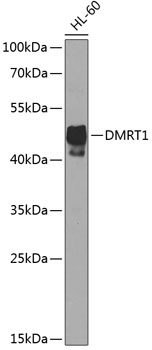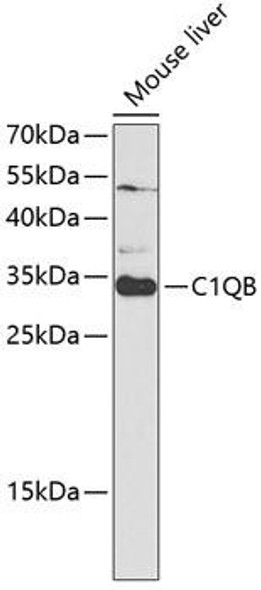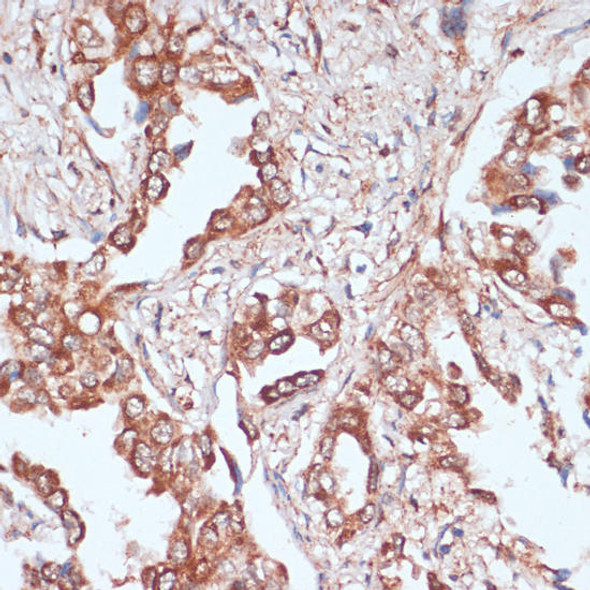Anti-DMRT1 Antibody (CAB8411)
- SKU:
- CAB8411
- Product type:
- Antibody
- Application:
- WB
- Reactivity:
- Human
- Host Species:
- Rabbit
- Isotype:
- IgG
- Research Area:
- Developmental Biology
Frequently bought together:
Description
| Antibody Name: | Anti-DMRT1 Antibody |
| Antibody SKU: | CAB8411 |
| Antibody Size: | 20uL, 50uL, 100uL |
| Application: | WB |
| Reactivity: | Human |
| Host Species: | Rabbit |
| Immunogen: | Recombinant fusion protein containing a sequence corresponding to amino acids 134-373 of human DMRT1 (NP_068770.2). |
| Application: | WB |
| Recommended Dilution: | WB 1:500 - 1:2000 |
| Reactivity: | Human |
| Positive Samples: | HL-60 |
| Immunogen: | Recombinant fusion protein containing a sequence corresponding to amino acids 134-373 of human DMRT1 (NP_068770.2). |
| Purification Method: | Affinity purification |
| Storage Buffer: | Store at -20°C. Avoid freeze / thaw cycles. Buffer: PBS with 0.02% sodium azide, 50% glycerol, pH7.3. |
| Isotype: | IgG |
| Sequence: | SHPI PLPS AAEL LVKR ENNG SNPC LMTE CSGT SQPP PASV PTTA ASEG RMVI QDIP AVTS RGHV ENTP DLVS DSTY YSSF YQPS LFPY YNNL YNCP QYSM ALAA DSAS GEVG NPLG GSPV KNSL RGLP GPYV PGQT GNQW QMKN MENR HAMS SQYR MHSY YPPP SYLG QSVP QFFT FEDA PSYP EARA SVFS PPSS QDSG LVSL SSSS PISN KSTK AVLE CEPA SEPS SFTV TPVI EEDE |
| Gene ID: | 1761 |
| Uniprot: | Q9Y5R6 |
| Cellular Location: | Nucleus |
| Calculated MW: | 18kDa/28kDa/39kDa |
| Observed MW: | 50kDa |
| Synonyms: | DMRT1, CT154, DMT1 |
| Background: | This gene is found in a cluster with two other members of the gene family, having in common a zinc finger-like DNA-binding motif (DM domain). The DM domain is an ancient, conserved component of the vertebrate sex-determining pathway that is also a key regulator of male development in flies and nematodes. This gene exhibits a gonad-specific and sexually dimorphic expression pattern. Defective testicular development and XY feminization occur when this gene is hemizygous. |
| UniProt Protein Function: | DMRT1: Transcription factor that plays a key role in male sex determination and differentiation by controlling testis development and male germ cell proliferation. Plays a central role in spermatogonia by inhibiting meiosis in undifferentiated spermatogonia and promoting mitosis, leading to spermatogonial development and allowing abundant and continuous production of sperm. Acts both as a transcription repressor and activator: prevents meiosis by restricting retinoic acid (RA)-dependent transcription and repressing STRA8 expression and promotes spermatogonial development by activating spermatogonial differentiation genes, such as SOHLH1. Also plays a key role in postnatal sex maintenance by maintaining testis determination and preventing feminization: represses transcription of female promoting genes such as FOXL2 and activates male-specific genes. May act as a tumor suppressor. May also play a minor role in oogenesis. Defects in DMRT1 may be a cause of testicular germ cell tumor (TGCT). A common solid malignancy in males. Germ cell tumors of the testis constitute 95% of all testicular neoplasms. Defects in DMRT1 may be a cause of 46,XY sex reversal type 4 (SRXY4). A condition characterized by male-to- female sex reversal in the presence of a normal 46,XY karyotype. Patients display complete or partial gonadal dysgenesis and a chromosome 9p deletion. Belongs to the DMRT family. 3 isoforms of the human protein are produced by alternative splicing. |
| UniProt Protein Details: | Protein type:DNA-binding Chromosomal Location of Human Ortholog: 9p24.3 Cellular Component: nucleus Molecular Function:protein homodimerization activity; transcription factor activity Biological Process: male sex determination; male sex differentiation; negative regulation of meiosis; negative regulation of transcription from RNA polymerase II promoter; positive regulation of mitosis; positive regulation of transcription from RNA polymerase II promoter; Sertoli cell differentiation; sex differentiation |
| NCBI Summary: | This gene is found in a cluster with two other members of the gene family, having in common a zinc finger-like DNA-binding motif (DM domain). The DM domain is an ancient, conserved component of the vertebrate sex-determining pathway that is also a key regulator of male development in flies and nematodes. This gene exhibits a gonad-specific and sexually dimorphic expression pattern. Defective testicular development and XY feminization occur when this gene is hemizygous. [provided by RefSeq, Jul 2008] |
| UniProt Code: | Q9Y5R6 |
| NCBI GenInfo Identifier: | 83305820 |
| NCBI Gene ID: | 1761 |
| NCBI Accession: | Q9Y5R6.2 |
| UniProt Secondary Accession: | Q9Y5R6,Q6T1H8, Q6T1H9, Q8IW77, B2R913, |
| UniProt Related Accession: | Q9Y5R6 |
| Molecular Weight: | 18,325 Da |
| NCBI Full Name: | Doublesex- and mab-3-related transcription factor 1 |
| NCBI Synonym Full Names: | doublesex and mab-3 related transcription factor 1 |
| NCBI Official Symbol: | DMRT1 |
| NCBI Official Synonym Symbols: | DMT1; CT154 |
| NCBI Protein Information: | doublesex- and mab-3-related transcription factor 1 |
| UniProt Protein Name: | Doublesex- and mab-3-related transcription factor 1 |
| UniProt Synonym Protein Names: | DM domain expressed in testis protein 1 |
| Protein Family: | Doublesex and mab-3 related transcription factor |
| UniProt Gene Name: | DMRT1 |
| UniProt Entry Name: | DMRT1_HUMAN |










